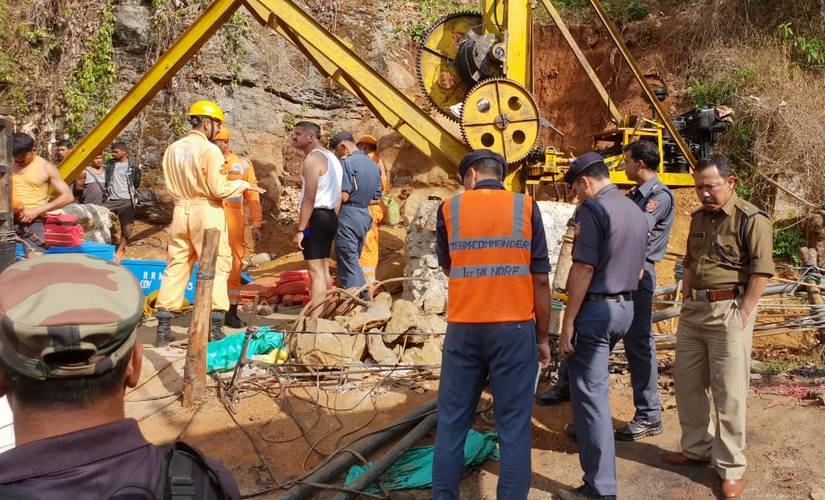Shillong: Coal miners in Meghalaya go down what's
literally a rat hole. It was in one such flooded rat hole that around 15
miners have been trapped since 13 December.
With the National Disaster Response Force (NDRF) unable to pump out
the water from the flooded mine even 10 days after the disaster, the
miners, in all probability, literally drowned like rats in the illegal
mine in the hills of East Jaintia district. Sayeb Ali, a 21-year-old
from Panbari village in Assam's Chirang district — the sole survivor of
the 13 December tragedy — said he earned more by entering these
dangerous rat holes of Meghalaya than what he did in his village.
This mine has been closed for years, since the National Green
Tribunal (NGT) had ordered a ban on all types of coal mining in
Meghalaya on 17 April, 2014, based on an application filed by the All
Dimasa Students' Union and the Dima Hasao District Committee from Assam.
Their petition claimed that illegal rat-hole mining in the Jaintia
Hills was polluting the Kopili river. While retaining the ban, the NGT
has since allowed the transportation of coal already extracted,
estimated in May to stand at around 1.76 lakh tonnes.
Meanwhile, at least five petitions by mine owners have challenged the
NGT's ban on coal mining in Meghalaya and are pending in the Supreme
Court.
Much of Meghalaya's coal production was through the now-banned
method. Rat-hole mining involves digging pits ranging from 5 to 100
metres deep vertically into the ground, mostly on a hill side, like a
narrow well, to reach the coal seam. These pits are so narrow that only
one miner can enter at a time. A small room-sized area is dug out at the
bottom. From this area, miners dig tunnels sideways to reach the coal
seam and extract it. This sideways digging of the rat hole is done
manually; it is completely haphazard and runs in all directions. The
coal thus dug is then extracted through a horizontal tunnel. If the mine
is near a river, or even below the level of a nearby river — as the
mine that flooded on 13 December was — the slightest breach of the walls
close to the river could cause catastrophic flooding, which NDRF
personnel theorise is probably what happened.
Meghalaya has total coal reserves of 640 million tonnes, most of
which is mined unscientifically by individuals and communities. As a
result, the water sources of many rivers, especially in the Jaintia
Hills district, have turned acidic. A majority of the mines are
privately owned, and illegal coal mining is rampant. The NGT-appointed
judicial commission under the chairmanship of BP Kakoti reported that
satellite data that the North Eastern Space Applications Centre
presented to the committee revealed that mining activities were on even
after the ban.
Records of the Meghalaya Police available online reveal that from
April 2014 to 7 November, 2018, there have been at least 477 reported
violations of the NGT's orders. These violations include illegal coal
mining, illegal transportation of coal and transportation of coal beyond
the permissible limit. This year, there have been at least 40 reported
cases, so far, that mainly concern illegal coal transportation. Truck
drivers, handymen and coal mine labourers were arrested, while
complaints against government officials for facilitating illegal coal
transportation have gone nowhere. The reported cases are from the
coal-rich belts and transit routes encompassing the districts of East
Jaintia Hills, West Jaintia Hills, East Khasi Hills, West Khasi Hills,
South West Khasi Hills, Ri Bhoi, and East, West and South Garo Hills.
Also, the Meghalaya government claims it has lost Rs 416 crore
because of the mining ban, but it remains tight-lipped about the various
reports alleging that politicians, bureaucrats and other government
officials, including senior policemen, are engaged in coal mining.
The state government has also been mum about the fact that mine
workers work in the most inhumane conditions. The NGT found that mine
owners don't implement the rules of safe mineral exploration in rat-hole
mining, despite the increase in the number of reported deaths of
labourers. There has also been little effort by the government, NGOs or
coal mine owners to spread awareness among workers, or give them any
sort of training about safety requirements.
Also, non-implementation of the
mineral policy and relevant labour laws has enabled mine owners to
completely ignore miners' safety, all to make a quick buck. The miners —
mostly poor migrant workers — are drawn to the possibility of earning
up to Rs 2,000 per day to dig those life-threatening rat roles.
GK Srivastav, joint general secretary of the all India coal workers'
federation, said the mines in Meghalaya are completely illegal and run
by coal mafias. "Those who work in these mines are exposed to health
hazards as there is no consultation with the Directorate General of
Mines Safety, the Indian government regulatory agency for safety in
mines and oil-fields," he pointed out, adding that the state government
has also been negligent by not carrying out regular inspections and by
putting the onus for this task on the central government.
Srivastava also spoke about the
Standing Committee on Mine Safety being unable to put an end to illegal
mining. "We have repeatedly told the government that in private mines,
there is a violation of safety guidelines. But they do not allow any
safety representatives to inspect these private mines. There are so many
guidelines, but it is the responsibility of the administration to
implement them. When the administration is patronising these coal
mafias, who can save these workers?"
Just how unsafe these mines are were highlighted in a 'Citizens’
Report' to Supreme Court-appointed amicus curiae Colin Gonsalves: "A
worker carries with him a pickaxe, a shovel and a wheelbarrow. As the
cave is dark, he carries a torch… If water has seeped into the cave, the
worker can enter only after the water is pumped out. Workers usually
enter the cave early in the morning and keep working till they are
tired, or hungry, or when they feel they have earned enough money for
the day."
But as survivor Sayid Ali said: "I know the mines are a danger to our
lives, but we have no option since we earn a good income digging coal."
Every miner this reporter spoke to echoed this opinion, including
Vivek Rana, a 32-year-old from Nepal who came to the coal mines of
Jaintia Hills when he was 18, like his friends before him. "It does not
matter whether the work is dangerous as long as I can send money to my
family in Nepal."
Another miner, Ram Rai, who had worked in Delhi, said: "A day's work at a dhaba
will not fetch us more than Rs 300. Working in the coal mines, we are
paid from Rs 1,000 to Rs 2,000 per day. Illiterate and poor, we work so
that we can have a bright future despite the dangers."
Meanwhile, Rofiot Zaman — a family member of Abul Kalam Sheikh, a
victim of the coal mine disaster from Rajabala's Magurmari village in
West Garo Hills district — said the family wants their child's body.
"His parents and siblings are inconsolable. He has a one-year old
child," Zaman said.
He added that there are seven people from his village trapped inside
the mine. A relative of Chal Dkhar, another trapped miner, said they
have been involved in this work for a very long time. and the whole
family is dependent on it. "We are poor, and through this job, we get
money for our daily needs. We never expected that such a fate will
befall us."





No comments:
Post a Comment